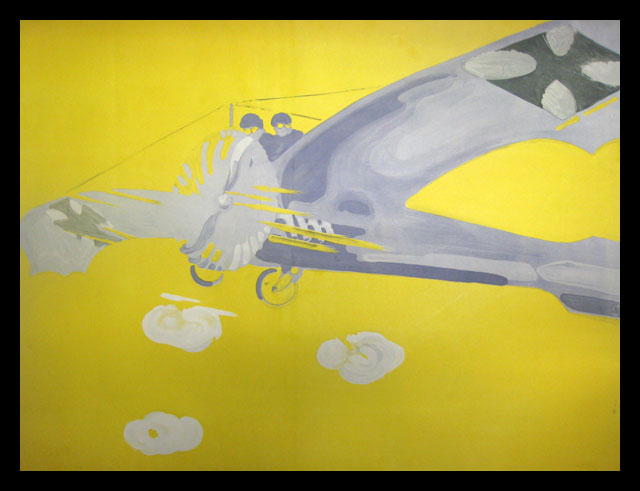
|
|
 |
Title: “TAUBE”
Description: The graceful blue aircraft soaring across the cloud-specked yellow sky in this image represents one of the most common monoplanes in the pre-World War I era, the “Taube,” German for “dove.” First designed by the Austrian Ignaz “Igo” Etrich (1879-1967) and his engineer, Franz Wels (1873-1940) the Taube airplane had its premier flight on November 1, 1909, near Vienna. It would be manufactured not only in Austria, but in Germany as well, where it would see service in World War I. |
|
Etrich and Wels had built a tailless glider and flown it in 1907, experimenting for a number of years before producing the Taube. With a 60-hp engine helping lift it into the skies, the bird-like craft was the first powered design to be created and manufactured in Austria. It was greeted with excitement when it soared aloft on that November day at Wiener-Neustadt, close to the Austrian capital of Vienna. In April of 1910, a Taube completed [piloted by whom?]a flight of 52 miles, flying at an altitude of 984 feet, which lasted 1 hour and 11 minutes. Etrich’s aircraft manufacturing firm entered the ranks of the up-and-comers in the world of aviation based on the Taube’s success. In fact, Austrian aviators surpassed all nations but the French in setting aviation records during the pre-WWI years. Vienna became a center of aeronautical science, although the Austro-Hungarian Empire did not succeed in creating an Imperial policy for aviation, such as that established by the French and Germans. As an example of this, when the war began, although the Taube was a primary craft for the Central Powers, Rumpler, a German airplane manufacturer, licensed the design and produced most of those aircraft used in the war. In recognition of the Austrian designer, the airplane was dubbed the Rumpler Etrich Taube. These early monoplanes structure and performance did not compare with contemporary bi-and triplane aircraft. Their slower speed and maneuverability and wings that sometimes folded in flight, caused crashes that killed pilots. In fact, in 1912, the British government considered grounding all existing monoplanes and ceasing any new production because of their inherent problems. The Taube, slow and stable, could not compete in the aerial field of battle with nimbler multi-wing craft, a critical failing in an arena where incremental differences in performance could mean life or death. Nevertheless, the Taube laid claim to some military fame. On November 1, 1911, an Italian lieutenant made the first aerial bombing run in history when he released four “homemade” bombs on a Turkish position from his Etrich Taube. The Germans put numerous Taubes into the field in World War I, most being manufactured by the Rumpler company, beginning in 1909. By 1912, between 200 and 300 Taubes per year were leaving the Rumpler factory, with the design of the craft having been modified significantly from the original Etrich plans. The airplane in this poster is the German military’s two-man version of the craft, often used for observation. Although this poster does not specifically advertise the airplane using logos and/or text, the image in 1912 would have been very familiar to anyone in the world of aviation, accustomed to seeing these slow yet charming doves of the air sail through the skies. The strong yellow and blue composition highlights the plane against its background, and the artist employs some technologically correct details in what is otherwise a stylized depiction of an early milestone in single-wing flight. |
|

